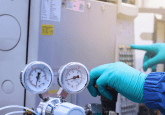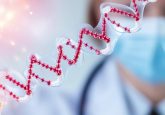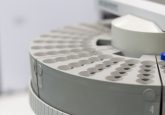Developing bioanalytical LC–MS/MS methods for biotherapeutics and biomarkers: an interview with William Mylott

William Mylott is the Associate Director for the Biologics by LC–MS/MS R&D group at PPD’s Bioanalytical Labs in Richmond (VA, USA). Mr Mylott earned a bachelor’s degree in chemistry from the State University of New York, College at Brockport (NY, USA) in 1992. He began his career in the environmental laboratory, conducting HPLC, GC-FID, GC-ECD and GC-MS analysis on environmental samples and later served as the ELAP Directory. In 1997, his career changed to pharmaceutical research when he joined Oneida Research Services (NY,USA; now part of ICON) as a project leader, where he conducted HPLC, GC-MS and HPLC–MS/MS bioanalysis for both preclinical and clinical studies. In 2005, he joined PPD as an R&D manager, overseeing the development and validation of LC–MS/MS assays for ‘small molecule’ therapeutics. Over the past few years, his focus has changed to overseeing the development and validation of LC–MS/MS assays for biotherapeutics and biomarkers, such as peptides, monoclonal antibodies, antibody drug conjugates and fusion proteins.
Introduce yourself and explain what began your interest in LC–MS?
My name is William Mylott and I am currently the Associate Director of the Biologics by LC–MS/MS R&D group at PPD located in Richmond (VA, USA). I have been in the analytical/bioanalytical field for over 26 years. In the beginning of my career, HPLC with UV detection was the workhorse of its time. Aliquot volumes of 1 mL and chromatographic run times of 10 to 30 minutes were common and required to obtain the necessary sensitivity and selectivity. Increasing throughput was conceptionally simple, just use more HPLC/UV systems. Then along came the first commercial LC–MS/MS systems. Being LC–MS naïve at the time, I can remember thinking the manufacturer claims about sensitivity, selectivity and run times were being exaggerated since it all sounded too good to be true. How could LC–MS/MS possibly be able to reach pg/mL LLOQs from <0.200 mL aliquots with run times of <5 min? Those questions drove my desire to learn more about LC–MS/MS and once exposed I was not only pleasantly surprised by the capability of the technology but also immediately hooked. Even after over 20 years of developing and validating bioanalytical LC–MS/MS assays, I am still amazed by its analytical power.
What are your/PPD’s current research focuses?
The PPD Biologics by LC–MS/MS group primarily focuses on developing bioanalytical LC–MS/MS methods in support of biotherapeutics and biomarkers. Areas of focus include peptides, PEGylated peptides and proteins, fusion proteins, monoclonal antibodies (mAb), bispecific mAbs, antibody–drug conjugates (ADCs), and bispecific drug conjugates. A fair amount of our research is in support of discovery or non-GLP preclinical studies. Methods are developed and appropriately qualified in a ‘fit for purpose’ mode. These types of methods are not considered ‘validated’, however, sufficient experiments are performed to ensure the methods are scientifically sound and thus capable of providing useful data that can be used for making decisions. An example would include a sponsors need to evaluate different ADC constructs, such as keeping the antibody and toxin constant and varying the linker chemistry and/or the conjugation site and/or the drug-to-antibody ratio (DAR). From this example, it can be easily seen how a large number of constructs are possible and to fully validate methods for each would be a very timely and costly endeavour. At the same time, the data generated from each construct has to have good scientific quality to provide reliable information needed for identifying a lead candidate.
A significant amount of our research involves developing and fully validating methods that are capable of supporting GLP toxicology studies. As the number of programs mature through the preclinical phase and into the clinical phase, our research efforts for developing and validating human methodologies is on the rise. For peptide therapeutics (<7000 Da), traditional small molecule extraction techniques are used followed by measuring the intact peptide. To achieve the necessary LLOQs, which are often in the single pg/mL range, we often use 2D chromatography. For larger protein therapeutics (>10kDa), we typically utilize a bottom-up approach, which involves an immunoaffinity capture enrichment followed by enzymatic digestion. As a result, a proteotypic peptide is identified and used as a surrogate analyte for the quantitation of the protein. A significant amount of our research is in support of protein biotherapeutics that are >10kDa. Therefore, I would have to say that hybrid LBA-LC–MS/MS is at the front of our research efforts.
Describe the technologies that you use? What are the advantages and disadvantages of such techniques?
As described previously, our research spans a very diverse category of biotherapeutics. Therefore, I will focus on the technologies that we typically employ for protein biotherapeutics (>10kDa) with an emphasis on mAb based biotherapeutics. For human or humanized mAb based therapeutics methods that need to be developed in a preclinical species, we often will employ a ‘Universal Method’ strategy. This involves use of a generic immunocapture step, such as Protein A or G coated magnetic beads or using streptavidin magnet beads coated with an anti-human Fc antibody, followed by standard denaturation, reduction, alkylation, and trypsin digestion (the reagents used are commercially available). The surrogate peptides used for quantitation are derived from the human sequences (light and heavy chains) that are proteotypic in animal matrices. The heavy chain peptide is used for quantitating the total mAb concentration and the light chain peptide is used for quantitating the intact mAb concentrations. The advantage of such strategy is the same methodology can be used across species (except human) as well as other mAb based biotherapeutics that are of the same isotype. In addition, a commercial uniformly isotopically labeled mAb is used as the internal standard, which helps track the immunoaffinity capture and digestion steps. This improves development efficiencies and significantly reduces the development time and ultimately the costs. An additional advantage of using this technique over the technique of pellet digestion, besides the obvious selectivity enhancement, is that the combined power of the immunocapture (via Fc) and subsequent selection of the surrogate peptides (heavy and light chain) provides useful information regarding the structural integrity of the therapeutic. For a pellet digestion, the structural integrity information can be lost, as degraded, partially degraded or dissociated antibody therapeutics would all be present during digestion and can lead to an overestimation or more importantly confusion to what is actually being measured.
A potential disadvantage of using the ‘Universal methodology’ is that if the therapeutic moves to human, different surrogate peptides would be required, most likely from the variable or CDR, which requires additional development. A disadvantage of using affinity capture vs pellet digestion is the higher reagent costs.
When developing assays in human matrix, an in silico digestion is performed and the tryptic peptides BLAST against the human proteome to identify potential proteotypic peptide candidates. Once identified, the affinity capture and digestion conditions are optimized. Depending on the required LLOQ, often times it is possible to use a Protein A or G capture, eliminating the need for special or specific capture molecules. The disadvantage to using a generic capture is related to the cleanliness of the final extract, which often negatively impacts the achievable LLOQ. Alternatively, assays developed using highly selective capture antibodies (anti-ID) or target antigens can overcome the generic capture LLOQ limitations. Therefore, techniques using selective capture offer a critical advantage over the more generic capture techniques by having superior selectivity and significantly improving the assay sensitivity. While reaching the necessary LLOQ may not be possible without the use of selective reagents, there are some disadvantages/challenges. The reagents are very specific to the therapeutic and thus not ‘universal’. As a result, capture and digestion optimization have to be done on an assay by assay basis. The reagents often are not commercially available and lot to lot variability has to be carefully monitored/evaluated to ensure assay performance is not compromised. Pre-existing antibodies, anti-therapeutic antibodies and soluble circulating targets can make it difficult to define what exactly is being measured: free, partially bound, total, or some combination. Therefore, it is often necessary to evaluate their potential impact during development.
What are the challenges you face with LC–MS bioanalytical methods for biotherapeutics?
Biotherapeutics literally come in all shapes and sizes, from small peptides (<7 kDa) to large proteins (900 kDa). Due to the size and complexity of many biotherapeutics, multiple assays may be necessary in order to adequately assess their pharmacokinetic profiles. Great examples are ADCs. Bioanalysis of ADCs are challenging as they require multiple assays to describe their pharmacokinetic profiles. To enable exposure-safety and exposure-efficacy analyses as well as to understand the metabolism of the ADC drugs three PK assays are typically employed: total antibody, antibody conjugated toxin or total ADC and unconjugated toxin. Comparison of total antibody concentrations to total ADC concentrations provides insight into the metabolism of the ADC in vivo and exposure-efficacy/safety analyses. Unconjugated toxin concentrations provide important exposure-safety data. While each of these assays have their own unique development challenges, an often over looked challenge, that can be a greater challenge than the science, is the sheer number of assays needed for each ADC. Starting with preclinical, there are often two toxicokinetic species needed, such as rat and NHP. Each species requires three assays to be developed and validated to support the GLP toxicokinetic studies. So for one ADC you immediately have six assays, not including potential immunogenicity assays, which often need to be worked on simultaneously to meet critical timelines. To support such programs, as well as other ADC programs, you must have appropriate trained personnel as well as number of people and equipment resources (mass spectrometers). Factor in subsequent sample analysis and you can easily see how resources/capacity can be a tremendous challenge.
Biotherapeutics are continuously evolving and as they evolve so must the bioanalytical methods evolve. For example, PEGylated (PEG) proteins are being developed with multiple PEG groups attached to a protein via a linker designed to be cleaved under physiological conditions. As the individual PEGs are released, the protein is exposed, thus becoming active before all of the PEGs have been removed, resulting in multiple active forms. To further complicate the development strategy, it may be necessary to discriminate between the active forms, which could depend not only on then number of PEGs cleaved but also the location of conjugation site. Another example includes ProbodyTM Therapeutics and ProbodyTM drug conjugates (PDC), which are based on cleavable peptide blocked CDRs. The CDR blocked antibodies are activated once the peptide has been cleaved. PDCs are further complicated as they also have conjugated drugs/toxins. What to measure is not always obvious and in the case of the PDCs could involve measuring total antibody, intact (contains blocking peptide(s)), total conjugated toxin, as well as unconjugated toxin. Another example would include PentarinsTM which are miniaturized biologic drug conjugates (mBDCs). Smaller does not translate to easier, as a receptor peptide ligand is conjugated to a toxin via a cleavable linkage. Again, what to measure is not straight forward. In this case it could involve measuring the intact mBDC, the total receptor peptide ligand, total conjugated toxin, and unconjugated toxin.
How can the field be regulated and standardized?
In May 2018 the Food and Drug Administration released a new guidance for Industry on Bioanalytical Method Validation, that addresses chromatographic and ligand binding validations, but does not specifically address hybrid LBA-LC–MS/MS assay validations. Looking at the background section of the guidance document, it is clear that it is based on workshops and published manuscripts that represent a collaborative effort between the FDA and scientific community. Therefore, I expect regulations and standardization for hybrid LBA-LC–MS/MS validations to follow a similar path of continued collaborations. Hybrid LBA-LC–MS/MS is still a relatively new technique that is rapidly maturing. As with any new technique it takes time to become an ‘established technique’ in the industry, which include scientists and regulators alike. Taking into account that programs supported by hybrid LBA LC–MS/MS really started gaining momentum as few as 5–7 years ago and that the drug development process, from pre-discovery through Phase 3 clinical trials, is estimated to take 11 years, it is easy to see why very few biotherapeutics, supported by hybrid LC-MS/MS, have yet made it all the way to submission. Over the next 5 years, I expect the number of submissions to dramatically increase, which in turn will be a significant driving factor for implementing and/or revising regulations addressing this technique. As biotherapeutics move through the maturation and drug development process, it is important that scientists and regulators continue to work together to establish and harmonize appropriate guidelines and regulations.
Where do you hope this field will be in 5–10 years’ time?
Over the next 5–10 years, I hope and expect that the analysis of Biologics by LC–MS/MS will significantly increase. As mentioned previously, the number of submissions should also dramatically increase, as many programs are nearing maturation. As a result, I am hopeful that successful submissions will help drive widespread acceptance and confidence, from regulators and scientists alike, in using LC–MS/MS to support biotherapeutics. LC–MS/MS is a powerful technique that can provide crucial alternatives to traditional LBA techniques. While I do not expect LC–MS/MS to replace the traditional LBA techniques, I am hopeful that the two techniques will become more synergistic and augment each other to provide additional information that may not be possible from either on its own. This will have a dramatic impact on drug development and design, thus improving medicines for all mankind.
Our expert opinion collection provides you with in-depth articles written by authors from across the field of bioanalysis. Our expert opinions are perfect for those wanting a comprehensive, written review of a topic or looking for perspective pieces from our regular contributors.
See an article that catches your eye? Read any of our articles below for free.






